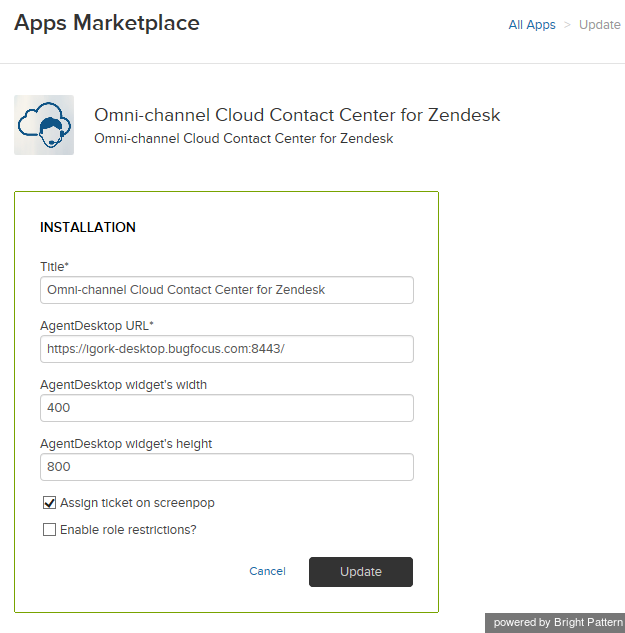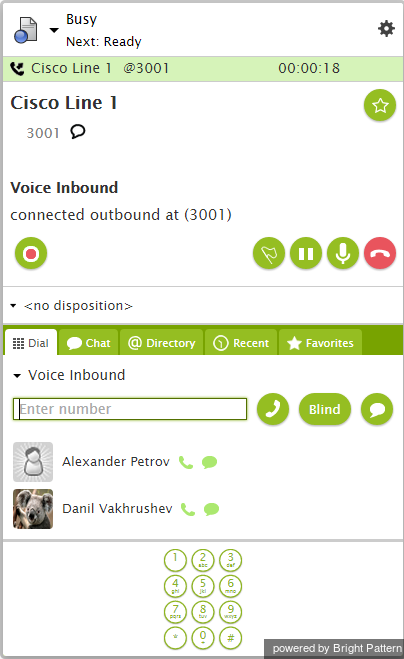Integrated Desktop, Click-to-Call and Activity History
Step 1. Log into your Zendesk application, click the Admin icon and go to the Apps > Marketplace page.
Step 2. Select the Omni-channel Cloud Contact Center for Zendesk application. Click Install App.
- Note: If you cannot find this application in Zendesk Marketplace, you can request it from the Bright Pattern Support. You will receive a .zip file. Upload this file via Apps > Manage > Upload App and click Install App.
Step 3. In the form that appears, specify the URL that you normally use to open your ServicePattern Agent Desktop application. The URL should have the following format: https://<tenant-name>.<service-provider-domain-name>/agentdesktop
Step 4. By default, current ticket assignments are not affected by customer interaction delivery to specific agents. If you want the system to automatically assign screen-pop tickets to the agents that the corresponding interactions are routed or transferred to, select the Assign tickets on screenpop checkbox.
Step 5. If you intend to provide an integrated desktop to all internal Zendesk users regardless of their roles, leave the Enable role restrictions checkbox unchecked. Otherwise, select the checkbox and choose the roles of users who will have access to the integrated desktop (hold the Ctrl button to select multiple roles).
Step 6. The ServicePattern Agent Desktop widget will be shown in the top-right section of the integrated desktop. You can adjust its size using the AgentDesktop widget’s width and height parameters. Note however, that its default size is optimized to make the interaction handling controls clearly visible to the agent while taking up as little Zendesk application screen space as possible. Thus you might want to try it with the default size setting before applying any changes.
Step 7. Click Update. You should now be able to see the ServicePattern Agent Desktop widget with a login dialog.
Step 8. Log in with your ServicePattern credentials. By default, you login with a softphone. To choose another device, click the current Phone device setting and select the desired type of device. For more information about the available device options, see section Selecting a Phone Device of the ServicePattern Agent Guide.
Note that if this is your first login into ServicePattern on the given computer, you will be prompted to install the Agent Desktop Helper Application.
Step 9. The ServicePattern Agent Desktop widget will now show a standard set of telephony controls available to a contact center agent. For more information about these controls see ServicePattern Agent Guide. Note that the appearance of these controls has been modified to match the overall look and feel of Zendesk application.
- Note: To minimize ServicePattern Agent Desktop Window, click the icon directly above it. When you are logged on, this icon reflects your agent state (or your presence state if you are not an agent). For example, when you are in the Ready state, the icon will look like this:
 . Agent states and corresponding icons are explained in section How to Interpret Your Current State Information of the ServicePattern Agent Guide. If you receive a new interaction, you will see the same interaction alert window that you would normally see in ServicePattern Agent Desktop and will be able to accept even if your ServicePattern Agent Desktop Window is minimized.
. Agent states and corresponding icons are explained in section How to Interpret Your Current State Information of the ServicePattern Agent Guide. If you receive a new interaction, you will see the same interaction alert window that you would normally see in ServicePattern Agent Desktop and will be able to accept even if your ServicePattern Agent Desktop Window is minimized.
- Note: To minimize ServicePattern Agent Desktop Window, click the icon directly above it. When you are logged on, this icon reflects your agent state (or your presence state if you are not an agent). For example, when you are in the Ready state, the icon will look like this:
Step 10. To test the click-to-call function, select a Zendesk ticket assigned to someone who has a phone number configured in the system. The name of this person will appear in the Dial tab of the Agent Desktop with a click-to-call icon ![]() next to it. Click this icon to make a call. When the call is answered, you should have all of the call control functions available to you via the integrated ServicePattern Agent Desktop Window (e.g., mute, hold, transfer, release). For more information, see ServicePattern Agent Guide.
next to it. Click this icon to make a call. When the call is answered, you should have all of the call control functions available to you via the integrated ServicePattern Agent Desktop Window (e.g., mute, hold, transfer, release). For more information, see ServicePattern Agent Guide.
- Note: When you transfer an interaction to another integrated desktop user, the Zendesk item that was open on your desktop at the time of transfer will be displayed for that user.
Step 11. To test the activity history function, release the previously established call. Upon completion of the after-call work, you should be able to see a new internal note added to the last open ticket with basic data about the call you just finished including start time, call type, phone number, duration (talk+hold time), disposition, service, and global interaction identifier. The latter is provided as a link. Clicking this link opens the Interaction Records Search page of the Contact Center Administrator application with the global interaction identifier preset as a search condition.
If the call was recorded, the activity history will also contain a link to the voice recording. When you click the link you should receive an incoming call. Playback of the recording will begin as soon as you answer this call. Note that in order to listen to the recording you must have privilege Listen to call recordings linked to CRM records.
Note that the basic activity history data set can be extended with custom fields using the Attached Data scenario block.
Step 12. To test the ServicePattern call center supervisor functionality, click the call center icon ![]() in the main menu of the Zendesk desktop on the left. ServicePattern Agent Desktop should now occupy the entire Zendesk working area. This full-screen Agent Desktop mode would normally be used by supervisors only.
in the main menu of the Zendesk desktop on the left. ServicePattern Agent Desktop should now occupy the entire Zendesk working area. This full-screen Agent Desktop mode would normally be used by supervisors only.
- Note: To be able to use the supervisor functionality, you must have privilege Access full Agent Desktop.
Step 13. To enable integrated desktop for other users of your system, make sure they all have privilege Use Zendesk.




